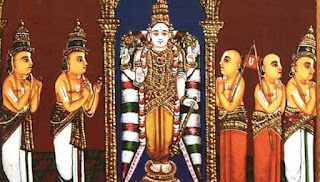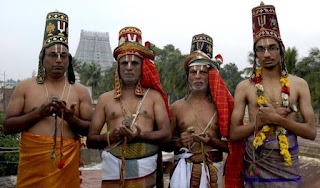On account of Covid-19 pandemic and a new virus Omicron threats, at many temples across Tamil Nadu and elsewhere 'temple festivities' are limited to the minimum as they attract huge gatherings of people. At Srirangam Ranaganathar temple, this year also the Vaikunta ekadasi festivities have limited audience. The TN govt. has introduced restrictions on devotees participating in temple festivities and it is done with good intention as the consequence of another bout of COVID -19 or some other virus threat is unthinkable. What has saddened me is this year, the Ariyar sevai, a rich tradition-bound performing art form, during Pagal pathu had very much limited audience. Under normal circumstances, lots of devotees would attend the pagal and ra pathu events and enjoy this seva with rapt attention. This year it is not so because the threat from the pandemic is not yet over. Though devotion is very much there among the devotees, they miss the joy of prayer and bakhti. With looming threat of Omicron on the horizon, the audience can not get immersed in such divine seva before the blissful god. Presented below is a brief account of Ariyar Seva, that is an integral part of Vaikunta ekadasi.
 |
| Ariyar Sevai, maalaimalar |
 |
| Ariyar Sevai, arayasamajam.blogspot.com |
Srirangam Ranganathar temple is closely connected with the Ariyar Sevai during the Vaikunta ekadasi festivities that last for 21 days - divided into Pagal pathu (10 days; prathamai following ammavasai till first dasami) and Rapathu (10 nights; after vaikunta Ekadasi till first panchami). During Pagal and Ra pathu, Ariyar sevai to the main deity is a great event and this tradition has been around here for centuries. The great Vaishnavite Savant Nadhamuni, (9th-10th Century A.D) was instrumental in introducing the Araiyar sevai at the Divayadesam shrines with a view to preserving the divine hymns of Naalayira Divya Prabandham and the bhakti tradition of singing, dancing and gestures. His idea was to instill devotion to Perumal among the devotees. This unique seva was first performed in Srirangam temple. The families, it is said, involved in Ariyar Sevai trace their hereditary link to Nathamuni and his close relatives.
This tradition of Ariyar sevai is being followed by a few temples in Tamil Nadu and in Karnataka. Presently, apart from Sri Ranganathat temple, Srirangam, Azhagiya Manavala Perumal Temple, Azhvar Tirunagari and the Andal Temple at Srivilliputhur in Tamil Nadu and at the Melkote temple (Thiru Narayanapuram, Mandya dist., of Karnataka) Araiyar sevai is conducted with religious fervor. In the latter Sri Ramanujar did lots of Kainkarya during his long sojourn at Melkote . I understand at Srivilliputhur temple Ariyar sevai is performed in the Tamil months of Thai and Adi besides Margazhi.
Ariyar swvai is a tradition-bound performing art form staged by trained Araiyars who hail from hereditary families. Truly, a distinctive devotional service, it is a right blend of music, dance, bhavam and dedication. There are families attached to the temples where Ariyar sevai is part of the temple worship and the family members dedicate their lives to the service of the lord ''Emperuman''.
During the Pagalpathu and Rapathu events, the place is charged with bakthi, and the ritual of singing and dancing with bhava by a group of Araiyars makes the audience spell-binding. Conducted in ''Tamil'' invoking devotion and soul-stirring hymns of Naalaiyara Divya Prabandham composed by Azhwar saints (5th century to 10th century CE, this seva promotes devotion and dedication to God.
This unique sevai is normally performed only on the temple premises right before the utchava murthy (the temple's processional deity). The performers recite devotional hymns from verses of Divya Prabangam with certain gestures (abhinaya) and commentaries. The most important criteria for Ariyars are commitments to their service to god, besides through understanding and meaning of Divya Prabamdham and pasurams, ability to sing,bring out right laya and bhava, nd make commentary with reference to particular verse . This sevai is called Adhyayanotsavam during the Vaikunda Ekadasi festivities at Srirangam Ranganathar temple. It takes several years for a devotee to get trained in Ariyar seva; quite time consuming and needs practice and patience.
Hailing from Si Vaishnava Brahmin families (both Vadakalai and Thenkalai), the performers and their families who belong to a hereditary institution retain their rights to perform on the temple premises. The performers, who follow different professions like engineering, civil service or teaching, etc., for livelihood claim their lineage from the first exponent of Sri Vaishnavism. They get a chance to bring out their talents and training during the Tamil month of Margazhi (Dec. 15th – Jan. 15th) when Vaikunta ekadasi festival is held.
In the realm of propagation of Bhakti, devotion and selfless service to God Ariyars have made a stellar contribution. This seva, a visual song and dance enactment of the ‘Paasurams’ that has been performed at many Divya Desams for over 1000 years is slowly on the decline and needs rejuvenation.
ttps://www.thehindu.com/features/friday-review/dance-of-devotion/article5003192.ece
https://en.wikipedia.org/wiki/Araiyar_Sevai
https://navrangindia.blogspot.com/2018/12/some-interesting-facts-on-vaikunta.html









